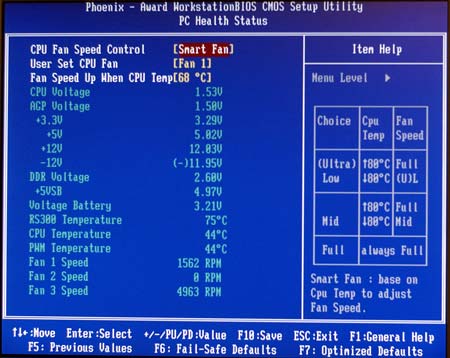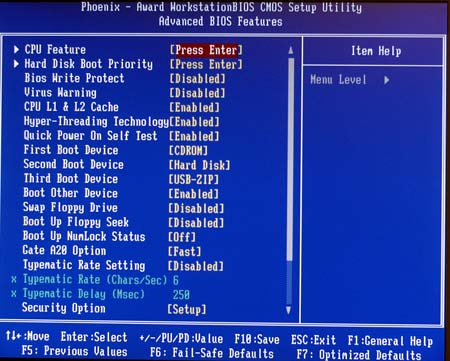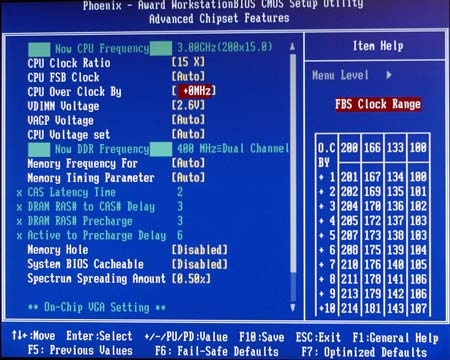Shuttle XPC ST61G4: Tiny Computer with Big Integrated Video
by Wesley Fink on January 23, 2004 12:23 PM EST- Posted in
- Systems
Shuttle XPC ST61G4: BIOS and Overclocking
Lately, Shuttle has been equipping their SFF computers with flexible BIOS options that allow the enthusiast to get the most from their SFF system. The ST61G4 is no exception, providing the full array of options that computer enthusiasts have come to expect in their motherboards, whether full-size or SFF.
Shuttle uses the familiar Phoenix-Award Bios in the ST61G4. The menu/submenu arrangement will be familiar to most users.

A full PC Health submenu with Smart Fan adjustments and a complete readout of fan speeds, temperatures, and power levels is provided. Shuttle pioneered the kind of fan controls on SFF that can deliver whisper-quiet day-to-day operation. The PC Health section continues the refinement of fan and thermal controls on Shuttle systems.

You will find the expected range of adjustments and boot sequence options in the Advanced BIOS Features section.

Instead of a separate Frequency/Voltage Control tab, Shuttle has included most of the voltage, memory timing, and FSB adjustments in the Advanced Chipset Features section.
It is important to point out, however, that the ST61G4 will not operate at any timings faster than 2-3-3-6 with either our Mushkin or OCZ test memory. The Mushkin SPD is programmed at 2-2-2-6 at DDR400, but the ST61G4 BIOS resets timings to 2-3-3-6. If you force the timings to 2-2-2-6 or 2-2-3-6 with either the Mushkin or OCZ memory the Shuttle will not boot. In comparison, both the OCZ and Mushkin perform fine at 2-2-2-5 or 2-2-2-6 settings at DDR400 in almost every Intel, nVidia, SiS, and VIA chipset motherboard. We do sometimes need to slow to 2-2-3-6 timings on certain boards, but the ST61G4 is the first board we have tested in quite a while to require 2-3-3-6 memory timings to operate.

FSB is officially adjustable to a unexpectedly low 232 setting, but adjustment is by the very odd selection of 1 to 15, which does not represent FSB increments at all. Shuttle includes a table to help in understanding the actual FSB that you are setting.
As usual, Shuttle has provided a complete selection of overclocking options, even if they are somewhat unfamiliar as implemented in the ATI 9100IGP. The FSB is extremely limited for a current Intel processor motherboard. This is particularly true when you consider many end-users are now easily reaching 250FSB at default voltage with air cooling using recent Intel processors. With a new and robust 250-watt power supply, which is huge by SFF standards, overclocking capabilities should not be held back by the power supply. This makes the BIOS limitation of a maximum FSB of 232 particularly puzzling.
FSB Overclocking Results
The last system that you normally think about overclocking would be a Small Form Factor, but as we demonstrated in our tests of the Shuttle, Soltek, and Biostar, the overclocking abilities can be outstanding on the latest SFF systems. We agree that you buy a system like the Shuttle ST61G4 for the small size and quiet operation. However, since we have proved in the past that you don't have to give up anything in a SFF system, we have made overclocking tests a standard part of SFF reviews.| Front Side Bus Overclocking Testbed | |
| Processor: | Intel 3.0 800FSB Pentium 4 |
| CPU Voltage: | 1.525V (default) |
| Cooling: | Shuttle ICE Cooling System |
| Memory: | 2 x 512MB Mushkin PC3500 Level II DS |
| Power Supply: | Shuttle Silent X 250W |
The highest stable FSB overclocking that we could achieve at default voltage was a very disappointing 213MHz at the +9 BIOS setting (852FSB) while running either the onboard ATI 9100IGP graphics or an ATI Radeon 9800 PRO. Since this CPU is known to do 3.6GHz+ at default voltage on many Pentium 4 mainboards, we can only conclude that the ATI chipset is currently holding back overclocking.
Increasing the CPU voltage and further relaxing memory timings did not really help in reaching a higher overclock. Nothing we tried would provide a completely stable system at the +10 setting of 214.
At 3.195 GHZ, the ST61G4 was completely stable. We ran the machine overnight, stress-tested, ran benchmarks, and still could not get the system to fail.
With the incredible headroom of current Intel processors, we can only hope ATI and Shuttle do not continue to ignore the overclocking capability of future ATI chipsets. This limited capability can seriously hamper sales when it is being compared to the excellent overclocking abilities of current Intel chipsets. We were particularly disappointed because the new 250-watt Silent X has the kinds of reserves that can take the tiny SFF machines to new levels of overclocked performance.










17 Comments
View All Comments
marvinpa - Wednesday, March 8, 2006 - link
From all of the reviews I got the impression this box would be very quiet, butthis was not the case. With expectations given by these reviews I must say the machine
keeps quite a loud humming sound. It has 4 fans in it, but the loudest is the one
connected to the cpu heatpipe in the back. The metal casing is also sensitive to resonance
sounds which are quite annoying.
Installing the sata drive was also quite an annoyance.
Apart from that the machine does perform quite well, and is optically pleasing.
Johnmcl7 - Sunday, April 4, 2004 - link
I see recommendations to go with an 865G system, but no actual SFF recommendations - would anyone care to provide some? I'm looking to rehome my 533Mhz P4, not bothered about overclocking and I like the look of the G4 case, as it's quieter and temps are lower. However, I do wish to use a 9800 pro graphics card, so I've been also looking at the Soltek EQ3401, however, this has no card reader and the temperatures are higher although it is slightly cheaper.John
sprockkets - Friday, January 30, 2004 - link
The ICE exhaust fan has always been 80mm on Shuttle systems. I use a Panaflo fan to make my system quiet. The picture of the rear of this unit seems dated because the new power supply has a new grill with less restrictions. Unless they changed that. The power supply in my Shuttle ss40G sounds ok to me, with a 2400+ Thorton installed and a Hitachi 120GB drive with Linux and Distributed Folding running it goes around 41C internal and 51c for the processor.SupermanCK - Thursday, January 29, 2004 - link
why no temperature readings...i can make a very quiet case too if there are no fans inside...i think that whenever you have a review with sound measured, you should always measure the temperature of the case too...artifex - Tuesday, January 27, 2004 - link
Well, from what I've been reading on the manufacturer website, there actually is a floppy connector on the mobo, and a cable, so you could install with an open case and leave the floppy hanging out in order to have the drivers for the SATA RAID when it asks for them.Still, in the future it'd be nice if actual useability issues like this were addressed a bit more. I'm not asking you to imagine all possible configurations, or anything, but if it says it supports something, a quick test to see if it's practically useable might be nice :)
SUOrangeman - Monday, January 26, 2004 - link
Just as an aside, there is apparently a way to embed drivers (for such things like RAID controllers) into you Win2K/XP/2K3 discs. I don't think that method was used in this case.In my free time, I'll have to see if this method actually works.
-SUO
vedin - Monday, January 26, 2004 - link
::doesn't know jack about setting up RAID:: Um, use a bootable CD?artifex - Sunday, January 25, 2004 - link
still wondering about the RAID/installation issue :)Wesley Fink - Sunday, January 25, 2004 - link
PrinceGaz -Thanks for catching the typo - corrected.
PrinceGaz - Sunday, January 25, 2004 - link
Looks like a nice small and quiet box for a caravan, dorm-room or the like, but it could never replace my main box.Its nice to see Intel have a sense of humour with their "Extreme" graphics, or is it meant to stand for "extremely slow"?
One slight typo on page 11- "As we have done on other SFF tests, the ST61G4 was loaded just as a user would likely set up their SFF system. We installed a 3.0 P4, 1 Mb DDR400 memory..." - personally I'd install slightly more memory in my SFF system ;)